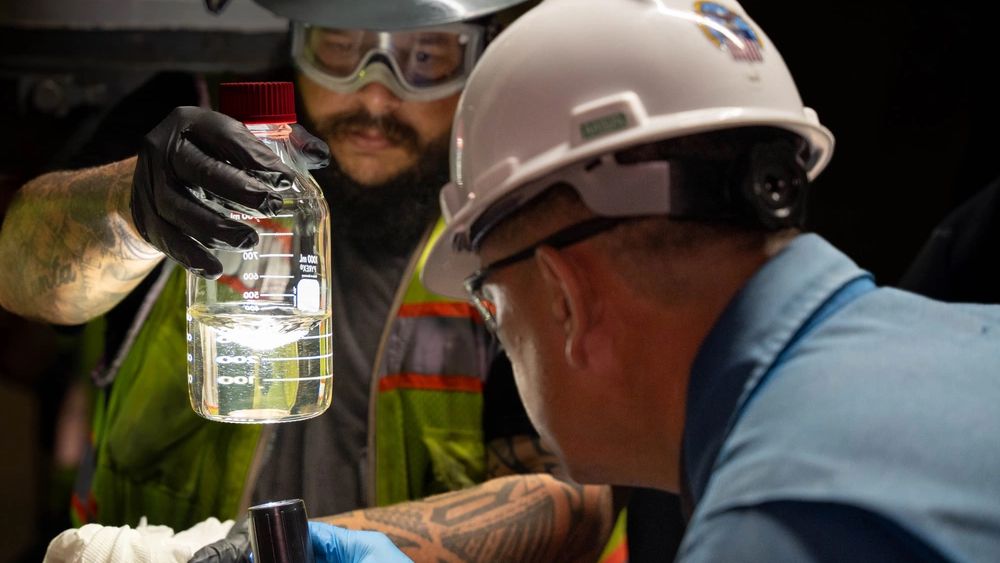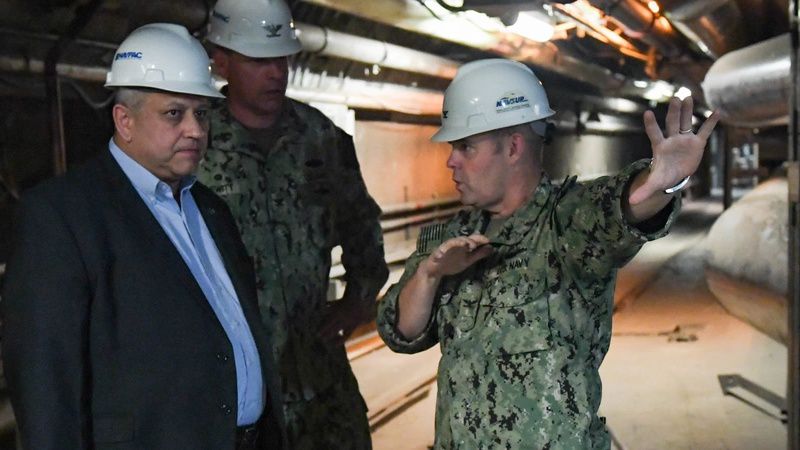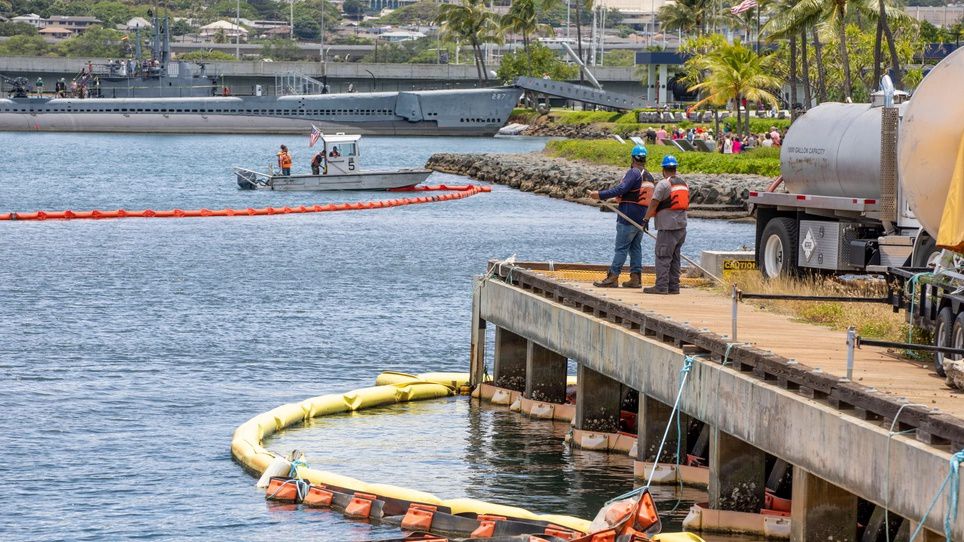In 2021, the U.S. Navy’s Red Hill Fuel Storage Facility leaked, and fuel entered Oahu’s groundwater, sickening thousands of people who use the Navy’s water system.
The following year, the Navy spilled aqueous film forming foam at Red Hill, which contains PFAS, a group of chemicals known to be persistent in the environment and cause adverse health effects. The impact of these two incidents is still emerging.
After facing mounting pressure, the Navy agreed to close the Red Hill facility — a slow process, as fuel must be drained from the giant underground tanks. Red Hill is not expected to be closed until 2027. After the fuel is removed, the Navy said it would like to repurpose Red Hill.
Spectrum News Hawaii looked back at our reporting from the past year to highlight some of the significant developments in the ongoing Red Hill crisis. Click on the links below to read the full stories.
1. Navy’s latest tests continue to show chemicals in soil near Red Hill
The Navy’s latest test results for PFAS showed they are above DOH Environmental Action Levels and EPA Regional Screening Levels, according to a release.
The test results come from soil samples taken at the Red Hill Bulk Fuel Storage Facility on Dec. 15, 2022, after the Navy spilled 1,100 gallons of Aqueous Film Forming Foam concentrate in November.
AFFF is a fire suppressant that contains per- and polyfluoralkyl substances (PFAS), which are known as forever chemicals because they are very slow to degrade. PFAS increase the risk of certain cancers, high blood pressure in pregnant women and other health problems.
Immediately after the spill in November, DOH took samples from excavated soil that also showed PFAS in the ground near the spill in excess of the DOH’s Environmental Action Levels.
In December, the Navy excavated soil from the spill site and covered it with asphalt.
In the release, the Navy said it would coordinate with DOH to determine what actions are now required to complete the spill cleanup.
2. Surveys will solicit input for the repurposing of Red Hill
Two surveys will ask Oahu residents how the Red Hill Bulk Fuel Storage Facility should be repurposed after fuel is removed, according to a Navy news release.
A qualitative survey will be released online in April, while a second quantitative survey will be released online and sent to households near Red Hill in June. Pre-paid postage will be provided for the mail-in surveys.
At the end of January, the Navy announced Nakupuna Companies, an independent contractor, had been hired to write a report based on public input about how to repurpose the Red Hill fuel tanks.
The Navy said in its release on Wednesday that Nakupuna and CommPac LLC, another local firm, will solicit input from community leaders, regulatory agencies, environmental groups and academics to craft the survey. SMS Research & Marketing Services Inc. will be conducting the survey.
After the report is complete in November, the Navy plans to meet with the Environmental Protection Agency and the Hawaii Department of Health to select the top five ideas. A final analysis will evaluate the feasibility of these ideas and then be presented to the state, DOH and EPA for consideration.
The Navy said in November last year that the repurposing use of the Red Hill facility would not include fuel. However, the Honolulu Board of Water Supply Chief Engineer Ernie Lau criticized the plan for not permanently closing the facility, expressing concern that the tanks would eventually be used for fuel again, according to the Honolulu Star-Advertiser.
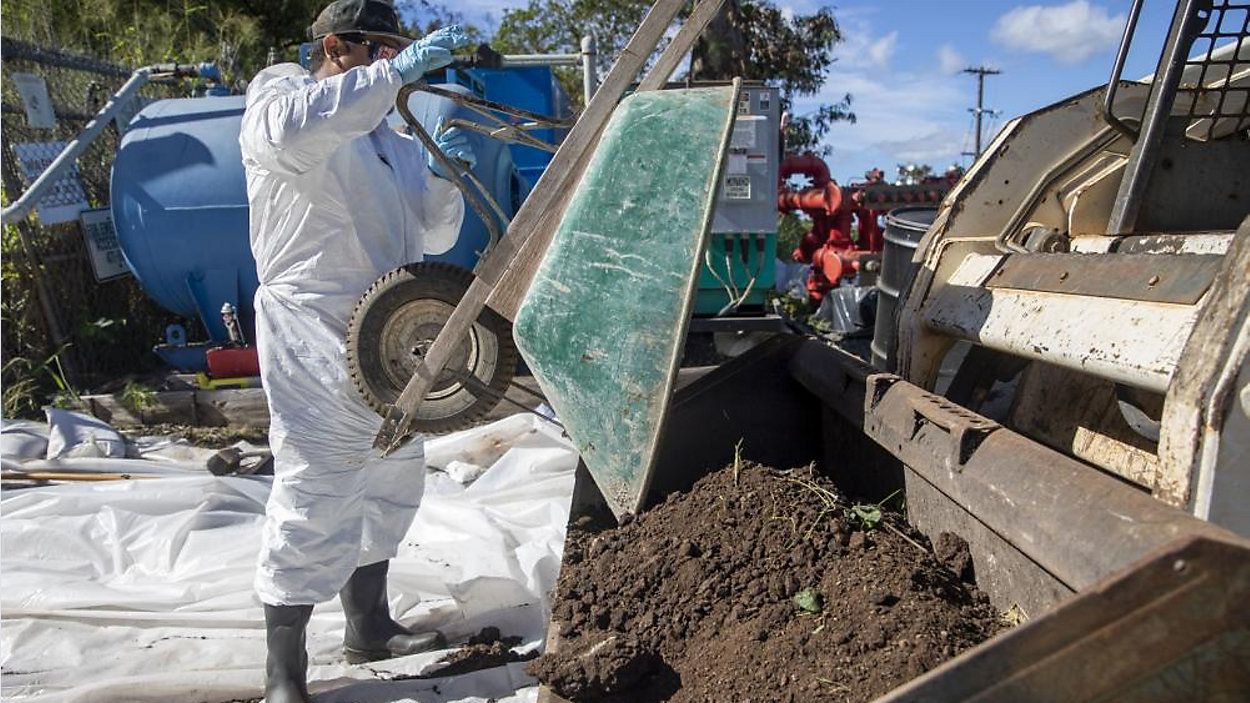
3. Navy announces findings from investigation into AFFF spill
The Navy announced this week that an improperly installed part and the failure to properly perform maintenance caused the AFFF firefighting foam to spill last November.
The investigation, led by Maj. Gen. Richard Heitkamp, the deputy commander of the U.S. Army Corps of Engineers, blamed the Nov. 29, 2022, spill on two factors. First, a maintenance contractor hired by the Navy improperly installed an air vacuum valve during a temporary modification to the AFFF fire suppression system at the Red Hill facility in April 2022. Second, employees from that same company failed to disable the AFFF pumps from automatically starting prior to running tests on the fire suppression system on Nov. 29, 2022.
The investigation also revealed that it took at least 20 minutes before the AFFF spill was noticed by a contractor, who was working a different maintenance job. After the contractor noticed the spill, it took him another eight minutes to report the spill because there was no accessible phone or radio.
During the spill, 13,000 gallons of a concentrated form of AFFF was released, with some seeping out of the Red Hill facility. AFFF contains PFAS, also known as “forever chemicals,” because they are slow to degrade. PFAS has been linked to many health problems.
The AFFF spill came after the 2021 fuel spill that contaminated drinking water for 93,000 residents. Both of these incidents eroded Hawaii residents' trust in the Navy.
“This mishap was preventable,” said Vice Admiral John Wade, who is the commander of the Red Hill Joint Task Force, during a news conference on Friday. He apologized on behalf of the Department of Defense.
4. Navy proposes removing 3 pipelines that transfer fuel to the Red Hill tanks
The Joint Task Force-Red Hill said the defueling process for the Red Hill Underground Fuel Storage Facility could start as early as Oct. 16, 2023. It also proposed removing the three pipelines that fill, drain and transfer fuel between the 20 Red Hill fuel tanks.
The Department of Defense said defueling could start as early as Oct. 16 in a supplement to the Defueling Plan, which was submitted to DOH and the Environmental Protection Agency on May 16. The process of removing 104 million gallons of fuel via gravity would be completed by Jan. 19, 2024. Previously, military officials estimated that defueling would start in February 2024 and be complete by the end of June 2024. However, DoD said up to 400,000 gallons would remain in the tanks at the conclusion of this process and would still need to be removed.
The Joint-Task Force Red Hill released a Draft Environmental Assessment on June 9 that analyzes potential environmental effects with gravity-based defueling of Red Hill. JTF-RH will host an informational meeting for the public on June 15, 2023, from 4 to 8 p.m. at the Harry and Jeannette Weinberg Memorial Hall at the Ke‘ehi Lagoon Memorial. The Draft EA is available for public comment until June 30.
The Navy submitted a supplement to its Red Hill Tank Closure Plan to the Hawaii Department of Health on May 31 that proposes removing all three fuel pipelines after the defueling process is complete. The Navy said removing the pipelines would reduce long-term maintenance costs. In November 2022, the Navy emptied the pipelines of fuel, so they could repair them before starting the defueling process.
The pipelines are in tunnels that connect the underground storage tanks to Joint Base Pearl Harbor-Hickam. All three together are 10 miles long. In the original Red Hill Tank Closure Plan submitted in November 2022, the Navy proposed the Red Hill storage tanks be repurposed for a non-fuel use. The Navy said in its recent supplement that removing the pipelines will allow more flexibility for using the tunnel space when repurposing Red Hill.
Closing the Red Hill facility will take about three years, according to the Navy. The Navy said removing the pipelines will not affect the closure timeline.
In June, the Hawaii Department of Health released its health report regarding the Red Hill fuel leaks in 2021, according to a news release. The report said along with jet fuel, the Navy’s water system may have been contaminated with an icing inhibitor, Simple Green and chlorine.
According to the report, exposure to high concentrations of hydrocarbons causes eye and skin irritation, dermatitis, defatting of skin, dizziness, headache, anesthesia, coughing, gagging, vomiting, griping, diarrhea, depressed respiration and pulmonary edema.
Along with jet fuel, the water may have been contaminated with other additives, including an icing inhibitor known as diethylene glycol monomethyl ether (DiEGME). The report said, “DiEGME is of particular concern for potential health risks both because of its relatively higher concentration in the fuel in comparison to other additives and its predicted miscibility in water.” Health effects of acute exposure to DiEGME include headache, dizziness, tiredness, nausea, vomiting and eye irritation. Long term-exposure may include impacts on the alimentary tract, kidneys, skin, and on the developmental and reproductive systems.
The water may have also been contaminated by chlorine, which can cause eye and nose irritation as well as stomach discomfort, according to the report. “Residents reported periodic strong chlorine odors emitted from tap water in the weeks following release. This was apparently related to intentional, increased chlorination of the water by the Navy to address concerns about potential buildup of bacteria in the system,” the report said.
The Navy also used Simple Green All-Purpose Cleaner to clean the floors and walls at the Red Hill facility following the Nov. 2021 spill. The use of Simple Green may explain why residents who used the Navy’s water system reported seeing foam-like residue in the tap water.
Along with exposure to contaminated water, residents in the Red Hill and Aliamanu Military Reservation areas may have been exposed to fuel vapors in the air. The fuel vapors would have been in the highest concentrations in the weeks following the fuel release, according to the report. Residents in the JBPHH area may have also been exposed to fuel vapors when they were asked by the Navy to flush the tap water in their homes. After the home flushing, people reported headaches, vomiting and other acute health effects. For months after the leak, fuel vapors were also emitted during heavy rainfalls from soil that was contaminated when untreated water was discharged.
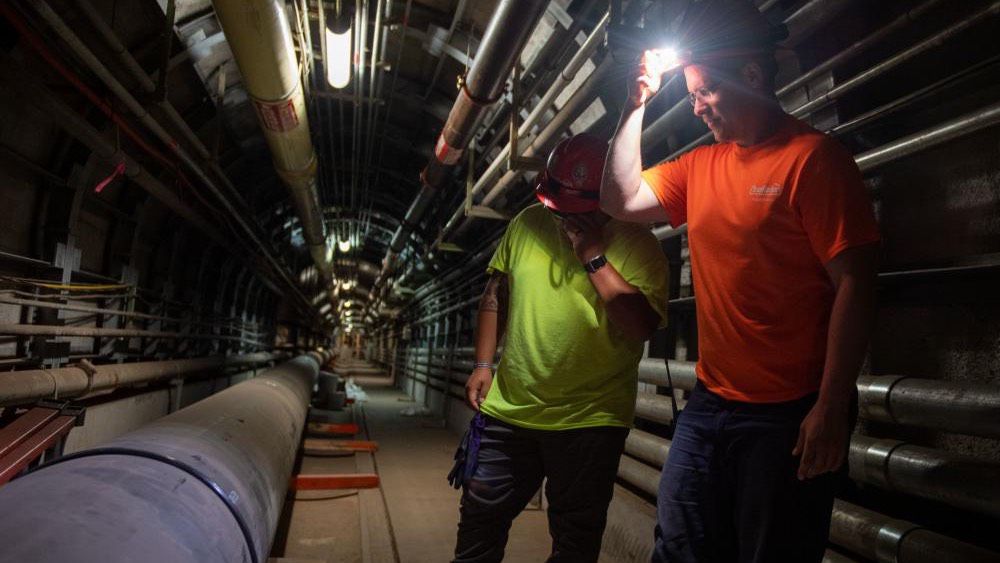
6. Red Hill defueling begins Oct. 16
Almost two years after a leak at the Red Hill Bulk Fuel Storage Facility contaminated Oahu’s drinking water, the facility’s 20 fuel tanks will be drained.
Joint Task Force-Red Hill Commander U.S. Navy Vice Admiral John Wade confirmed in a video message that the defueling of Red Hill is set to begin on Oct. 16, 2023.
The process of removing 104 million gallons of fuel via gravity will begin in three weeks and will be completed by Jan. 19, 2024.
The Joint Task Force-Red Hill is currently working to obtain final approvals from the Environmental Protection Agency and the Hawaii Department of Health.
“This is an important part of the oversight process because they hold us to federal and state standards, ensuring that we execute the mission safely,” said Wade.
After the gravity-based defueling is completed, up to 400,000 gallons of fuel will remain in the tanks and will still need to be removed.
7. The Navy names several officers accountable for Red Hill fuel spills
Navy Secretary Carlos Del Toro sent letters of censure to three now-retired officers who were in leadership roles during the Red Hill fuel spills in 2021, according to a news release.
The three Secretarial Letters of Censure were sent to:
Rear Adm. Peter Stamatopoulos, who was the Commander for the Naval Supply Systems Command during the spills
Rear Adm. John Korka, who was the Commander for the Navy Facilities Engineering Command Pacific before the spills
Rear Adm. Timothy Kott, who was the Commander for the Navy Region Hawaii during the Nov. 2021 spill
The SLOC to Stamatopoulos said he failed to perform his duties by not ensuring proper readiness to respond to the Nov. 2021 fuel spill at Red Hill, which was the cause of the drinking water contamination. The letters also listed specific failures for the other officers.
“You are hereby censured for your leadership failures,” all three letters said. The SLOCs will remain in each officer’s official service record.
Del Toro sent the SLOCs after receiving recommendations from Adm. Daryl Caudle, who is the Commander for the U.S. Fleet Forces Command. Adm. Caudle considered all Navy service members whose behavior may have been called into question during the May and Nov. 2021 spills, according to the Navy’s news release.
“What happened was not acceptable and the Department of the Navy will continue to take every action to identify and remedy this issue,” said Secretary Del Toro. “I have determined that there were no leaders in relevant positions at the Red Hill Bulk Fuel Storage Facility worthy of an end of tour award over the period in question.”
8. ‘Important milestone’: Department of Health conditionally approves defueling of Red Hill tanks
The Hawaii Department of Health said on Tuesday that it conditionally approved the Joint Task Force Red Hill’s plan to defuel the Red Hill Bulk Fuel Storage Facility’s main tanks, according to a news release. The defueling process is set to begin on Oct. 16.
The DOH said its approval is contingent on JTF-RH adhering to the plan and other requirements listed in its approval letter. JTF-RH plans to remove about 104 millions of fuel from the tanks via gravity. Staff with DOH will be on-site during the defueling to oversee it.
“Today’s conditional approval marks an important milestone in the process that will ultimately result in permanent closure of the Red Hill Facility and remediation of our aquifer,” said Deputy Director of Environmental Health Kathleen Ho. “Many people have worked for many months to reach this milestone, and we appreciate and fully expect that the Joint Task Force will continue to uphold its commitments to the people of Hawaii and our environment.”
The JTF-RH was required to complete 297 repairs, with oversight and approval from DOH. The health department also observed spill drill exercises, the defueling of four surge tanks in July, and repacking two of the three pipelines from August to September.
In order to complete the defueling process, DOH still needs to approve JTF-RH’s plan for unpacking the pipelines and removing up to 400,000 gallons of residual fuel.
Michelle Broder Van Dyke covers the Hawaiian Islands for Spectrum News Hawaii. Email her at michelle.brodervandyke@charter.com.





